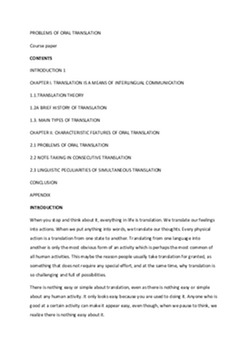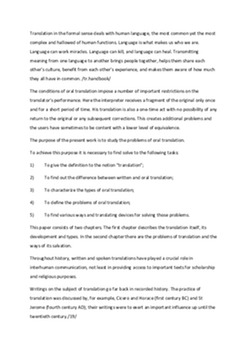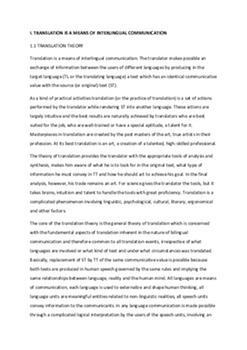The problems of oral translation



Introduction.
Translation is a means of interlingual communication.
A brief history of interpretation.
Main types of translation.
Characteristic features of oral translation.
Note taking in consecutive translation.
Model.
Linguistic peculiarities of simultaneous translation.
Conclusion.
When you stop and think about it, everything in life is translation. We translate our feelings into actions. When we put anything into words, we translate our thoughts. Every physical action is a translation from one state to another. Translating from one language into another is only the most obvious form of an activity which is perhaps the most common of all human activities. This maybe the reason people usually take translation for granted, as something that does not require any special effort, and at the same time, why translation is so challenging and full of possibilities.
There is nothing easy or simple about translation, even as there is nothing easy or simple about any human activity. It only looks easy because you are used to doing it. Anyone who is good at a certain activity can make it appear easy, even though, when we pause to think, we realize there is nothing easy about it.
Translation in the formal sense deals with human language, the most common yet the most complex and hallowed of human functions. Language is what makes us who we are. Language can work miracles. Language can kill, and language can heal. Transmitting meaning from one language to another brings people together, helps them share each other’s culture, benefit from each other’s experience, and makes them aware of how much they all have in common. /tr.handbook/
The conditions of oral translation impose a number of important restrictions on the translator's performance. Here the interpreter receives a fragment of the original only once and for a short period of time. His translation is also a one-time act with no possibility of any return to the original or any subsequent corrections. This creates additional problems and the users have sometimes to be content with a lower level of equivalence.
The purpose of the present work is to study the problems of oral translation.
To achieve this purpose it is necessary to find solve to the following tasks:
2)To find out the difference between written and oral translation;
5)To find various ways and translating devices for solving those problems.
This paper consists of two chapters. The first chapter describes the translation itself, its development and types. In the second chapter there are the problems of translation and the ways of its salvation.
Throughout history, written and spoken translations have played a crucial role in interhuman communication, not...
- Microsoft Word 24 KB
- Latviešu
- 22 lapas (6384 vārdi)
- Universitāte
- Saniitis
-

